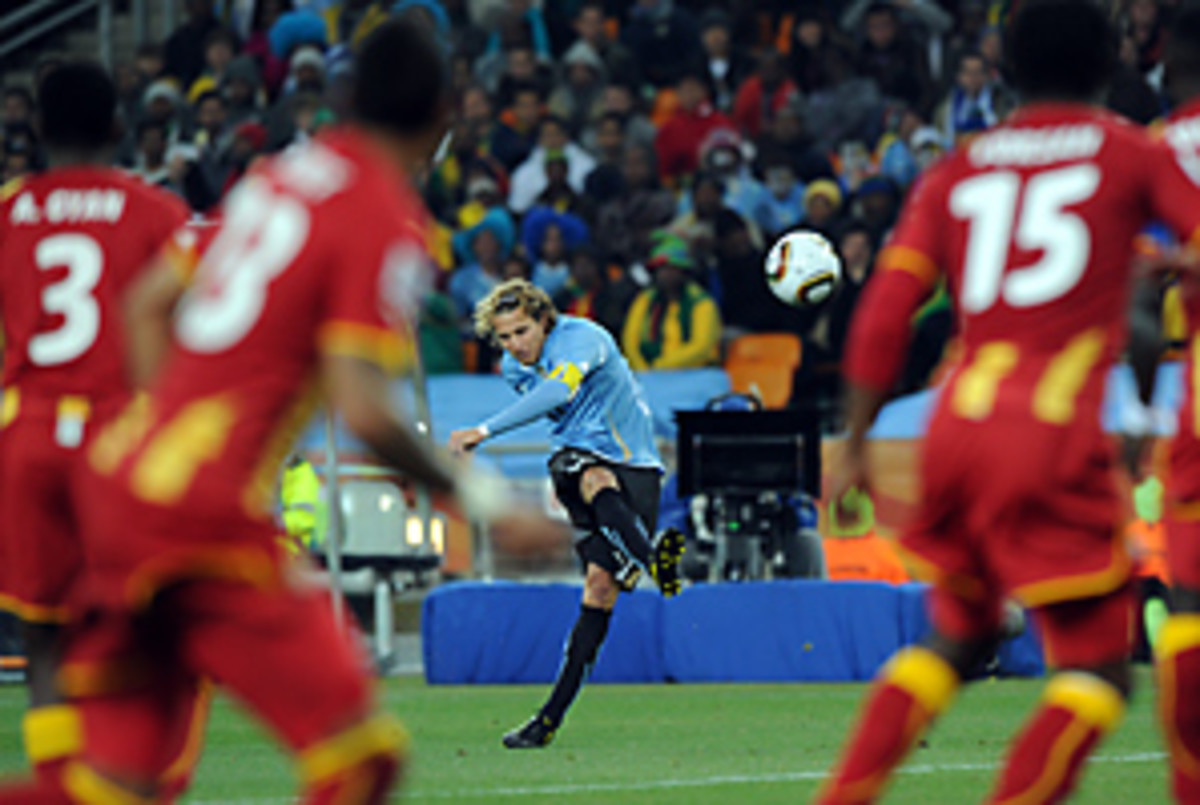Uruguay rides luck against Ghana
There had been a mounting sense of Ghana pressure when John Pantsil clipped in that late free kick. In the scramble that ensued, Luis Suarez blocked a Stephen Appiah effort on the goal line with his shin, and then a Dominic Adiyeh effort with his hand; a clear penalty and a red card, and Gyan was one kick from glory. He blew it, and so an engaging game that ebbed one way then the other was decided by penalties.
Uruguay has been admirably flexible with its tactics in this tournament, switching from a negative 3-5-2 against France to juggle between 4-3-1-2 and 4-3-3 as required. Against Ghana, though, Oscar Washington Tabarez opted for a flat 4-4-2, the reasoning presumably being that his side could be caught narrow if Ghana, as they had against the U.S., played a 4-1-4-1 with Samuel Inkoom and Sulley Muntari (in for the suspended Dede Ayew) wide.
The problem when 4-4-2 meets a five-man midfield, though, is not merely that it is outnumbered in the middle, but that the five-man midfield, whether arranged as 4-1-4-1 or 4-2-3-1, tends to be able to pick angles between the banks of four (when all else is equal, triangles will usually beat lines). To an extent Uruguay got round that by sitting the two central midfielders Egidio Arevalo and Diego Perez very deep, restricting the opportunities of Kwadwo Asamoah and Kevin Prince-Boateng to get forward from midfield.
Initially, when Ghana's shape was 4-1-4-1, the ploy worked. Ghana was restricted in midfield, and never built up the sort of early momentum they had against the U.S.. Although Suarez and Diego Forlan seemed a little isolated, every chance in the first half hour went Uruguay's way. None of them came from what might be called constructive play, but there were enough loose balls and set pieces to think that Uruguay would probably win quite comfortably, albeit by playing safety-first football and waiting for a Ghanaian mistake.
The smallest things, though, can turn games, and when Isaac Vorsah soared to meet a right-wing corner on the half-hour, sending his header flashing just over the angle of post and bar, Ghana and the local crowd were enthused. Suddenly Ghana began to find the angles, with the link-up of Pantsil and Inkoom on the right particularly threatening. Still, the opener, when it arrived in first-half injury-time, came from nothing. Perhaps Uruguay's two central midfielders got too deep, perhaps they could have closed Muntari down more quickly, but they could hardly has expected him to unleash a shot from 35 yards that, with Fernando Muslera unsighted, squeezed inside the right-hand post.
Tabarez's response was to replace Alvaro Fernandez with Nicolas Lodeira, which allowed Edinson Cavani to return to the right flank, where he seems more natural, and where, being right-footed, he offers width. The shape remained 4-4-2, but at least there was thrust from midfield. Uruguay began to control possession and territory and Cavani had had a decent shout for a penalty turned down before Forlan swept his free kick from wide on the left over Richard Kingson and in.
Thereafter the sides matched each other, punch for punch. Tabarez brought on Sebastian Abreu for Cavani, and switched to a 4-3-3, which allowed Forlan to pull wide left, and gave Uruguay control in the middle of midfield. Ghana's coach Milovan Rajevac countered by withdrawing Inkoom for Stephen Appiah, making Ghana more compact. A match that had begun with a game of cat-and-mouse on the flanks ended with both sides packing the center, both coaches preferring to sacrifice the possibility of creating chances from wide areas for the greater security of packing the middle.
Still chances came; Uruguay should have had a penalty when Abreu was fouled by Pantsil, while Andres Scotti almost gave Ghana a goal as he deflected a Gyan shot over his goalkeeper -- only for the ball to be hacked clear before any onrushing Ghana forward could take advantage.
Again, though, the sense was that Ghana had not created as many chances as it probably should have done in its spells of supremacy.
Uruguay, of course, is a master of letting the opposition have the ball while denying it chances, but Ghana's lack of cutting edge, of real imaginative spark, has been a feature of its play for the past year. It survived one similar battle of nerves against the U.S., but this time, with Gyan struggling to make much of an impression against Scotti and Mauricio Victorino, Ghana was unable to find a second goal.
Tabarez must take great credit for coaxing Uruguay this far, but the semifinal presents by far his greatest test. So far, with the exception of the France game -- and the subsequent revelations from the French camp rather downgrades its quality -- Uruguay has come up against players of less than or of equal stature to its own. Against the Netherlands it would, anyway, have been facing a squad of greater talent, but now it must do so without its center forward, Suarez, and its left back, Jorge Fuclie, both of whom have been excellent but will be suspended. Tabarez could also possibly be without its captain and center-back Diego Lugano, who hobbled off with an injury seven minutes before halftime. The Dutch will be without the suspended Nigel De Jong, but its loss is by far the lesser. And after four tactical triumphs, this recent progress felt rather fortuitous.





